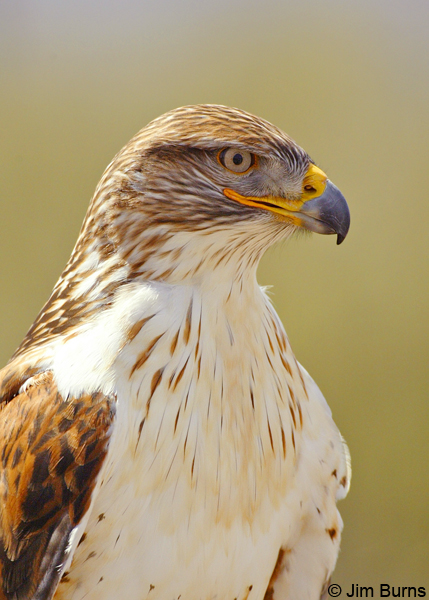By request, I'm going to write today about one of my favorite feathered brethren. I live with many birds here in the Educational Ambassador cage complex, ranging from Screech Owls to Rough-Legged Hawks to Peregrine Falcons to Barn Owls. But the bird just down the hall from me is easily the Queen of the Hawks. She reminds us all what it means to be a fierce and wild predator, and consequently I have a deep respect, sight unseen, for any of her species that come through the RMRP's doors.
 |
| jimsburnsphotos.com |
What makes them so impressive? It's a combination of appearance and attitude. Say you are walking in the plains and you surprise a Ferruginous Hawk. There are probably two things that you notice right away: it's huge, and it's coming right for you.
Let's start with appearance. The Ferruginous Hawk is the largest hawk in the world (well, it's a tie, actually, between the Ferruginous Hawk and the Upland Buzzard of Asia), measuring 4-5 feet from wingtip to wingtip, and weighing 2-5 pounds. In comparison, small Golden Eagles have 6 ft wingspans, and weigh ~5-6 pounds. Ferruginous Hawks stand tall and proud with a regal posture, which perhaps is why their Latin name, Buteo regalis (royal hawk), fits them so well. They're so big that they're often mistaken for Eagles. In fact, numerous species of Eagles around the world are actually smaller than Ferruginous Hawks (it's takes more than size to qualify as an Eagle).
 |
| Jo Matson |
 |
| David Quanrud |
Then there's the attitude. If they're mistaken for Eagles based on size, the same mistake could be made in regards to attitude. Ferruginous Hawks are mean and wild, and have no qualms whatsoever about defending themselves. When the Humans are taking care of an injured Ferruginous Hawk here at the RMRP, only very experienced catchers take on this bird.
The reason for this intense attitude could stem from where these birds live: on the plains. While nests will be built in trees if they're available, Ferruginous Hawks usually nest in open areas such as rock outcrops, or simply on the ground. The plains environment just doesn't provide many protected nesting opportunities. Since nesting sites are so exposed, the birds have to be able to defend themselves not only from aerial predators like most Raptors have to, but also from terrestrial predators like Coyotes. And if the chicks are on the ground for the first month of their lives, you can expect the chicks to be as fierce as the parents.
 |
| Baby Ferruginous Hawk at the RMRP. Chicks have a buff-colored bib. |
 |
| Ferruginous Hawk on a power pole |
If you see a Ferruginous Hawk in the wild, consider yourself lucky! Be sure to appreciate its awesome beauty and power, and wish it the best of luck out there in the harsh plains environment.

Saw one of these gorgeous ladies being taken for a walk today by her carer. What a privilege to be able to see her so close up.
ReplyDeleteI have never seen one of these incredible birds before. I live in the mountains of northern Arizona and wondered if they are migratory and that's why I am seeing him/her here just before Easter
ReplyDeleteI have a Ferruginous Hawk on top of a street lamppost in Calgary, Alberta Canada. The bird is gorgeous!
ReplyDeleteShe has been here since May 17 th , there was two of them now I just see one. I am sure when I am at work the mate is there with her. I had to find out what type of bird this was as it is very large , first I thought it was an Eagle. This is so amazing to have this majestic bird across the street. I keep looking out my window to make sure she is ok.